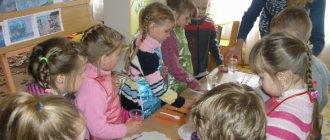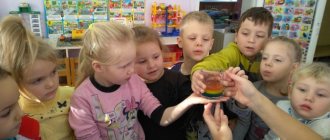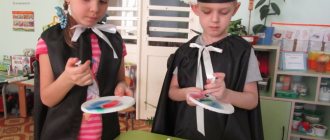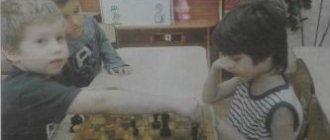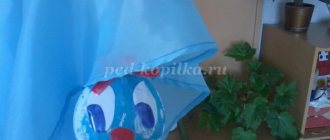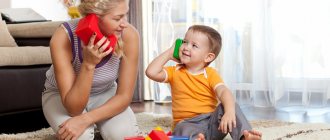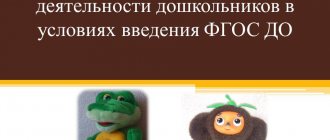Experimental activities of preschool children
Introduction
In accordance with the Federal Law “On Education in the Russian Federation,” preschool education in Russia has acquired the status of the first level of general education. Relations in the field of preschool education in the implementation of educational programs are now regulated on the basis of the Federal State Educational Standard for Preschool Education.
The federal state educational standard is aimed at solving many problems. One of them is “the creation of favorable conditions for the cognitive development of children in accordance with their age and individual characteristics and inclinations, the development of the abilities and creative potential of each child as a subject of relationships with himself, other children, adults and the world...” (hereinafter referred to as the Federal State Educational Standard for Education). (Federal State Educational Standard 1.6) [8].
Currently, the latest developments, technologies, and methods are being formed and successfully applied in the preschool education system, which make it possible to raise the level of preschool education to a higher and higher quality level. One of such effective methods of understanding the patterns and phenomena of the surrounding world is experimental activity.
It is known that familiarization with any subject or phenomenon gives the most optimal result if it is effective. One such activity is experimentation. The works of many domestic teachers (N.N. Poddyakova, A.P. Usova, E.L. Panko) say that children's experimentation claims to be the leading activity in the period of preschool development, and highlight the main feature of this cognitive activity: the child learns an object in the course of practical activities with it, the practical actions carried out by the child perform a cognitive, orientation and research function, creating conditions in which the content of this object is revealed.
It is experimental activity that helps a preschool educational institution graduate meet the requirements of the Federal State Educational Standard, according to which a graduate today must have such qualities as curiosity, activity, which encourage interest in the new, unknown in the world around him. In the course of experimental activities, the preschooler learns to observe, think, compare, answer questions, draw conclusions, establish a cause-and-effect relationship, and follow safety rules.
Specially organized experimental activities allow students to obtain information about the phenomena or objects being studied, and the teacher to make the learning process as effective as possible and more fully satisfy the natural curiosity of preschoolers.
The purpose of the study is to study the features of the organization of experimental activities of preschool children.
The object of the study is the educational activities of preschool children.
The subject of the study is the features of experimental activities in preschool educational institutions.
Research objectives:
- consider the concepts of experiment and experience;
— study the features of organizing experimental activities in accordance with the age of preschool children;
— to identify the conditions for organizing experimental work in preschool educational institutions.
The practical significance of the work lies in the fact that methodological materials can be used in the work of teachers of preschool educational institutions.
Definition of the concept of “experiment”, “experience”
Currently, we are witnessing how another effective method of understanding the patterns and phenomena of the surrounding world is being formed in the preschool education system - the method of experimentation.
The word “experiment” comes from Greek and is translated as “test, experience.”
The “Modern Dictionary of Foreign Words” contains the following definition[6]: An experiment is:
— “scientifically staged experiment, observation of the phenomenon being studied under scientifically taken into account conditions, allowing one to monitor the progress of the phenomenon and reproduce it many times when these conditions are repeated”;
- “generally an experience, an attempt to accomplish something.”
“An experiment... is a systematic observation. Thus, a person creates the possibility of observations, on the basis of which his knowledge about the patterns in the observed phenomenon is formed” [3, p. 459].
“Experiment... sensory-objective activity in science; in a narrower sense of the word - experience, reproduction of the object of knowledge, testing of hypotheses, etc.” [5, p. 1034].
From the above definitions it is clear that in the narrow sense of the word the terms “experience” and “experiment” are synonymous: the concept of experience essentially coincides with the category of practice, in particular, experiment and observation.
So, like most words in the Russian language, “experimentation” is a polysemantic word. It acts as a teaching method if it is used to transfer new knowledge to children. It can be considered as a form of organizing the pedagogical process if it is based on the method of experimentation. And finally, experimentation is one of the types of cognitive activity of children and adults, as can be seen from the definitions given above.
Experimental activities of preschoolers in accordance with age characteristics
Summarizing his own rich factual material, N.N. Poddyakov formulated the hypothesis that in childhood the leading activity is not play, as is commonly believed, but experimentation [4].
To substantiate this conclusion, he provides evidence.
1. Play activities require stimulation and a certain organization on the part of adults; the game must be taught. In the activity of experimentation, the child independently influences the objects and phenomena around him in various ways (including other people) in order to more fully understand them. This activity is not assigned to an adult child, but is constructed by the children themselves.
2. In experimentation, the moment of self-development is quite clearly presented: the transformations of an object carried out by a child reveal new aspects and properties of the object to him, and new knowledge about the object, in turn, allows him to make new, more complex and perfect transformations.
3. Some children don't like to play; they prefer to do something; but their mental development proceeds normally. When deprived of the opportunity to get acquainted with the world around him through experimentation, the child’s mental development is inhibited.
4. Finally, fundamental evidence is the fact that the activity of experimentation permeates all areas of children's life, including play. The latter arises much later than the activity of experimentation.
Thus, it is impossible to deny the validity of the statement that experiments form the basis of all knowledge, that without them any concepts turn into dry abstractions. In preschool education, experimentation is a teaching method that allows a child to model in his creation a picture of the world based on his own observations, experiences, establishing interdependencies, patterns, etc.
Since interest in experimentation arises from an early age, classes on children’s experimentation in kindergarten begin with the 2nd junior group.
With the help of game characters, children are presented with the simplest problem situations: Will a paper boat sink? How to hide a ring in water from a fox? Why can't you eat snow? How to walk on ice without falling, etc.
In the second younger group, children master the actions of transfusion, pouring various materials and substances. Get acquainted with the properties of some materials and inanimate objects: water, ice, snow. They learn about light sources, that if you shine light on an object, a shadow will appear, that different objects and animals make different sounds, etc.
In the 5th - 6th year of life, children continue to enrich their experience in understanding the world around them. At this stage, children begin to practically master the properties and qualities of various materials, children actively participate in the study and transformation of various problem situations, and become familiar with ways to record the results obtained. Experiments are conducted with children to identify the causes of individual phenomena, for example, “Why did this handkerchief dry faster?” (because it was on battery); “Whose house is stronger: what materials did the wind blow away the house from and why.” Children learn to compare the properties of sand and clay, learn and expand their understanding of the properties of water and air, their meaning, the types and properties of fabrics, and learn about the properties of a magnet and a magnifying glass.
During joint experimentation, it is necessary to set a goal, put forward hypotheses, jointly determine the stages of work, and draw conclusions.
In the process of experimentation, children often receive completely unexpected information, which leads to significant restructuring and change in their activities. This demonstrates the flexibility of children's experimentation - the ability to rearrange their activities depending on the results obtained. The organization of experimentation work is carried out in three interrelated areas [1]:
— living nature (characteristic features of seasons in different climatic zones, diversity of animal organisms, their adaptation to the environment, etc.);
- inanimate nature (air, water, soil, electricity, sound, weight, light, color, etc.);
— man (functioning of the body, man-made world, transformation of objects, etc.).
In the process of experimentation, children acquire interpersonal communication and cooperation skills: the ability to negotiate, defend their opinions, and reason in dialogue with other children. To do this, when discussing problematic situations, you need to draw children’s attention to the opinions of others, teach them to listen to each other, and invite more active children to help shy ones.
Also teach children to ask questions during activities, highlight the sequence of actions, reflect them in speech when answering questions like: what did we do? what did we get? Why?
After each experiment, children should be taught to be independent when cleaning the workplace.
In the 6th and 7th years of life, children’s ideas about the world around them become increasingly deeper, and experiments become more complex in content and methodology.
Now the initiative to conduct experiments more often belongs to children. The tasks of predicting results are gradually increasing. For example, “Today we planted oat grains, think about what it will be like in 10 days.”
It is necessary to encourage children to independently analyze the results of experiments, the desire to draw conclusions, and compose a detailed story about what they saw. Experimentation can be organized in the following forms: joint (partnership) activity of the teacher and students, independent activity of children.
Conditions for organizing experimental activities in preschool educational institutions
The organization of experimentation in a preschool educational institution presupposes the fulfillment of certain psychological and pedagogical conditions that contribute to the achievement of positive results. These conditions include three main components: content, subject-development environment and psychological comfort. Let's take a closer look.
Speaking about the content of organizing experimental activities for children, it is advisable to note the need to create a file cabinet of experiments and experiments.
The role of the card index can hardly be overestimated, since this material is the main assistant to the teacher in preparing and organizing children's activities, because each of the cards reflects information about the purpose and objectives of the experiment, its content, equipment that is necessary for the experiment and a fixed expected result. In addition, the card index principle allows you to systematize the available materials depending on the age of the children, topics and program content. Moreover, the system of developed forms of experimental activity does not contradict, but, on the contrary, is an integral part of complex thematic planning of the entire educational process.
The second condition for solving problems in experimental activities in kindergarten is the organization of a developmental environment. The main requirements for the environment as a developmental tool are to ensure the development of active independent children's activities. Therefore, when equipping and organizing a space for experimental activities of preschoolers, it is necessary to zone it thoughtfully and productively.
In the experimental activity corner (mini-laboratory) the following should be highlighted [2]:
1. A place for a permanent exhibition, where a mini museum is located, which can house various collections. Exhibits, rare items (shells, stones, crystals, feathers, etc.)
2. Place for devices. The main equipment in the corner are assistant devices, such as: microscopes, magnifying glasses, compass, scales, hourglasses, magnets. Technical materials: nuts, paper clips, bolts, nails . Food and non-food dyes (gouache, watercolor paints. Medical materials: pipettes, flasks, wooden sticks, syringes (without needles), measuring spoons, rubber bulbs and other materials.
3. A place to store natural and “waste” materials (pebbles, shells, pine cones, feathers, moss, leaves, etc.; wire, pieces of leather, fur, fabric, plastic, cork).
4. The testing area must be sufficient and unobstructed to accommodate a minimum of 2 people. It is better that this place can be mobile to provide visibility from all sides when demonstrating the experiment.
5. Place for unstructured materials (sand, water, sawdust, shavings, foam plastic, etc.) Materials in this zone are distributed in the following areas: “Sand and water”, “Sound”, “Magnets”, “Paper”, “Light”, “Glass and plastic.
The material for conducting experiments in the experimentation corner changes in accordance with the work plan.
To support interest in experimentation, some problem situations are formulated on behalf of the fairy-tale hero.
So, for example, a Wise Dwarf can live in the laboratory, on whose behalf tasks - notes - are offered. For example, one day the children found an envelope with bean and pea seeds and a note: “Explain what appears at the beginning: the root or the stem?”
In the process of experimentation, children form not only intellectual impressions, but also develop the ability to work in a team and independently, defend their own point of view, prove its correctness, determine the reasons for the failure of experimental activities, and draw basic conclusions. A competent combination of materials and equipment in the corner experimentation contributes to children’s mastery of the means of cognitive activity, methods of action, examination of objects, and expansion of cognitive experience.
And lastly, it is known that not a single educational or educational task can be successfully solved without fruitful contact with the family and complete mutual understanding between parents and teacher. In individual conversations, consultations, and at parent meetings through various types of visual agitation, we convince parents of the need for daily attention to children’s joys and sorrows, encouraging the child’s desire to learn new things, independently find out what is incomprehensible, and understand the essence of objects and phenomena.
Conclusion
Children's experimentation is a special form of search activity in which the processes of goal formation, the processes of the emergence and development of new personal motives that underlie the self-movement and self-development of preschool children are most clearly expressed.
The use of experimental activities in pedagogical practice is effective and necessary for the development of preschoolers' research activities, cognitive interest, increasing the amount of knowledge and the ability to master this knowledge.
Since experimental activities provide a preschooler with the opportunity to directly satisfy his inherent curiosity and streamline his ideas about the world.
Thanks to cognitive interest, both knowledge itself and the process of acquiring it can become a driving force in the development of intelligence and an important factor in the education of the individual.
Thus, the experimentation method allows children to implement the self-development program inherent in them and satisfy the need for cognition in an effective and accessible way for them - through independent exploration of the world. Cognitive interests have a great motivating influence on the process and result of learning.
This allows preschoolers to fully form the prerequisites for educational activities at the stage of completing their preschool education.
Literature.
1. Derevova S.N. Experimental activities of older preschoolers in accordance with the requirements of the Federal State Educational Standard of Preschool Educational Institution / Website “Academy of Preschool Education” (https://www.adou.ru/categories/2/articles/160)
2. Dorokhova T.M. Organization and conduct of experimental activities with preschoolers / All-Russian electronic journal “Preschool Education Teacher” (https://www.pdou.ru/categories/2/articles/2028)
3. Brief philosophical encyclopedia. - M.: Progress, 1994. - 576 p.
4. Poddyakov, A.N. Development of research initiative in childhood: Author's abstract. dis. ... doc. Psych.Sc. –M., 2001.
5. Soviet encyclopedic dictionary. ed. A. M. Prokhorov. M. Soviet Encyclopedia. 1987.
6. Modern dictionary of foreign words. - M.: AST-PRESS KNIGA, 2012.
7. Chemodanova M.V. Experimental activities as a means of cognitive development of older preschoolers // Collection of materials of the Annual International Scientific and Practical Conference “Education and Education of Young Children”. - 2016. - No. 5. — P.970-972.
8. Federal State Educational Standard for Preschool Education [Electronic resource]: Access mode - https://www.firo.ru/wp-content/uploads/2013/11/PR_1155.pdf (access date 09/25/2016).
Attention! Promotion until January 14!
Author: Yuzenko Irina Mikhailovna
Modern children live and develop in the era of information technology. In a rapidly changing life, a person is required not only to possess knowledge, but also, first of all, to be able to obtain this knowledge himself and operate with it, to think independently and creatively. We want to see our students as inquisitive, sociable, independent, creative individuals who can navigate their surroundings and solve emerging problems. The transformation of a child into a creative personality depends largely on us, teachers, on the technology of the pedagogical process; in this regard, one of the main tasks of a preschool educational institution is to support and develop the child’s interest in research and discovery, and to create the necessary conditions for this.
In connection with the introduction of the federal state educational standard, traditional education is being replaced by productive learning. This training is aimed at developing children’s creative abilities, developing preschoolers’ interest and need for active creative activity. We, teachers, must develop the creative abilities of the child’s personality, which are determined by the tasks of children’s research and experimental activities. The goal of the work of kindergarten teachers is to develop knowledge about the world around them through children's experimentation. What kind of person would we like our graduates to be? Able to act independently in various types of children's activities; be interested in new, unknown things in the world around you; take an active part in the educational process. During the research approach, the training of preschoolers is based on the child’s direct experience, on expanding the active exploration of the world. Children are not given ready-made knowledge. Teachers create a problematic situation, which the child can solve if he draws on his experience, establishes other connections in it, while mastering new knowledge and skills. Experimental activities lay the foundations of logical thinking, ensure maximum efficiency of the intellectual development of preschool children and their full readiness for learning at school. An effective method that promotes the development of cognitive activity of children in preschool educational institutions is the method of children's experimentation, which includes both live observation and experiments conducted by the child. The purpose of children's experimentation is the development of children's cognitive activity, the desire for independent knowledge of the phenomena of the surrounding world. The tasks that the teacher sets when working on the development of cognitive activity in children: develop mental processes (perception, imagination, memory, thinking); ensure active intellectual and cognitive development; activate children's cognitive interests; expand children's horizons and knowledge about inanimate and inanimate nature, the man-made world; learn to plan your activities, put forward hypotheses, draw conclusions, establish cause-and-effect relationships.
Experimentation permeates all areas of children's activity: eating, playing, studying, walking, sleeping. The activity of experimentation contributes to the formation of cognitive interest in children, develops observation and mental activity. In order for experimentation to become a leading activity, it must arise on the initiative of the child himself. An obligatory element of the lifestyle of preschoolers is participation in resolving problem situations, conducting basic experiments, experimenting, and making models.
It should be noted that at the age of 3 years, children cannot yet operate with knowledge in verbal form, without relying on visual evidence, so in the vast majority of cases they do not understand the explanations of an adult and strive to establish all the connections on their own.
After 5 years, a stage begins when children’s activities diverge in two directions: one direction turns into play, the second into conscious experimentation.
Thus, for preschool children, experimentation, along with play, is a leading activity
The role of development of experimental activities of preschool children is very great. Children's experimentation is of great importance in the development of children's intellectual abilities.
Everything is assimilated firmly and for a long time when the child hears, sees and does it himself. For successful development, it is necessary to pay more attention to the creation of conditions and the activity of the children themselves.
During an experiment, preschoolers learn to set a goal, solve problems, put forward hypotheses and test them empirically, and draw conclusions. Children experience great joy and surprise from their small discoveries, which give them a feeling of satisfaction from the work done.
During the experimentation process, the child needs to answer the following questions:
– How do I do this?
– Why do I do it this way and not otherwise?
– Why am I doing this, that I want to find out what happened as a result?
When conducting experiments, work is most often carried out in stages: after listening and completing one task, the children receive the next. However, due to an increase in memory capacity and increased voluntary attention, in some cases you can try to give one task for the entire experiment and then monitor the progress of its implementation. Children's level of independence increases.
In kindergarten, experiments are carried out with inanimate objects, plants and animals. Simple experiments can be used in children's games; they can be associated with their work in a corner of nature and in the garden, and be included in classes.
In the process of organizing search activities, children acquire the ability to independently set cognitive tasks that reflect a deeper penetration into the essence of natural phenomena, the establishment of analogies, and an understanding of increasingly general patterns.
When guiding children’s search activities, it is important to create conditions for solving every problem that arises on their initiative.
During the learning process, children's search activity improves. Its dynamics are manifested in the transition from accepting cognitive tasks set by the teacher and solving them with the help of an adult to independently setting and solving them. Gradually, children develop the ability to independently formulate search tasks.
Methodological requirements for conducting elementary experiments:
1. The teacher must simply and clearly formulate the task facing the children (for example, is the grass warm under the snow or not)
.
2. For the purpose of greater clarity, you should take two objects: one is experimental, the other is control (for example, some oat crops should be watered, others not)
.
3. Mandatory guidance of experience: questions that require the child to form a holistic idea of an object or phenomenon, encouraging him to reason, explain, and compare.
4. Carry out the same experiment twice, so that children are convinced of the correctness of the conclusions, and also in order to attract children who did not show interest in it the first time.
5. When conducting an experiment, make sure that everything possible is done so as not to harm living objects.
It is most advisable to organize experimental activities with children of senior preschool age. By this time, preschoolers will have already accumulated a certain amount of information; they will learn to compare facts and natural history information, which will allow them to successfully solve the problem posed in the experiment. However, there is no doubt that experimental activities
children need to be prepared. Preparation is carried out at the stage of primary and secondary preschool age by conducting various research sessions with children.
Thus, familiarizing preschoolers with the phenomena of inanimate nature (physical phenomena and laws) occupies a special place in the system of diverse knowledge about the environment. One of the pressing problems of the modern education system is the development of curiosity, cognitive and creative activity of each individual. According to psychologists and teachers, creative activity is one of the meaningful forms of human mental activity. The creative process is a special form of qualitative transition from the already known to the new, unknown. For preschoolers, this transition is carried out through the organization of various forms of experimental and research activities.
Literature
1. Kosolapova N. G., Formation of search and investigative behavior in preschool children in the process of creating projects, Irkutsk, Publishing House of Irkutsk State Pedagogical University, 2008.
2. Marudova E.V., Familiarization of preschoolers with the world around them. Experimentation, St. Petersburg, OOO Publishing House DETSTVO-PRESS, 2010.
3. Organization of experimental activities of preschool children, Methodological recommendations, ed. L. N. Prokhorova, 3rd ed., revised. ,Moscow, ARKTI, 2005.
